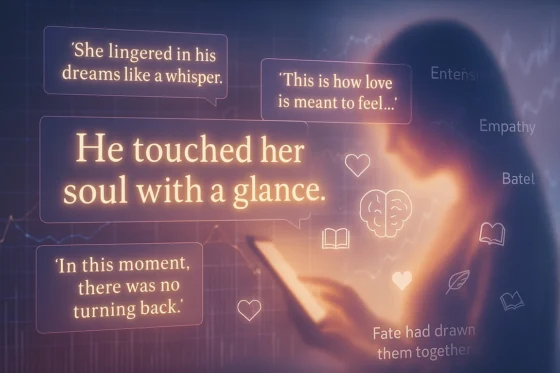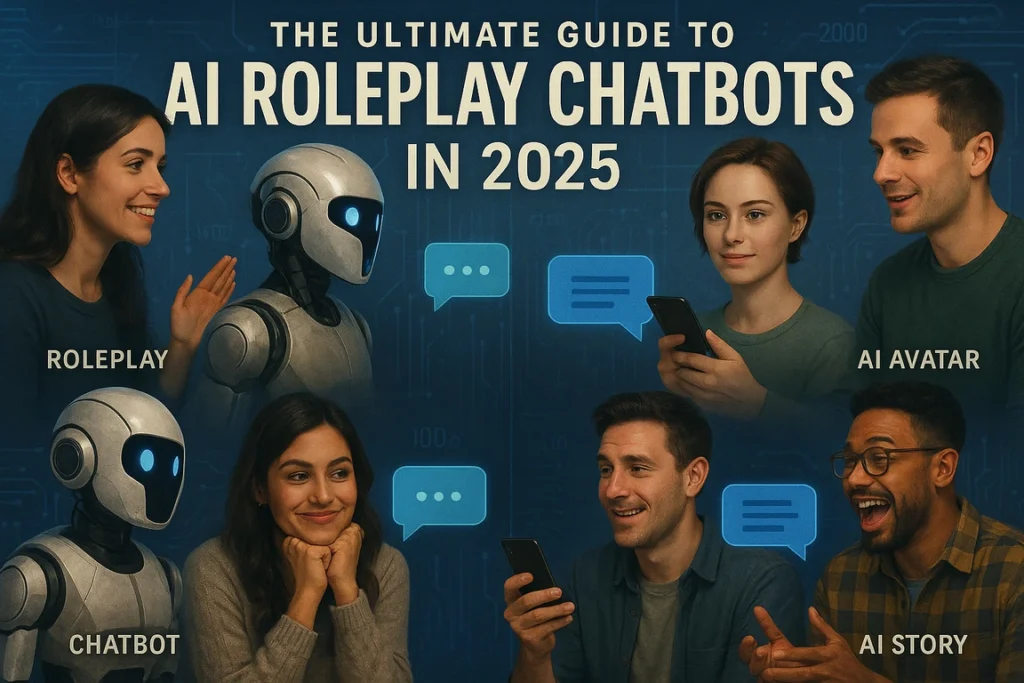In 2025, a roleplay AI chatbot has become a powerful tool for immersive storytelling, emotional interaction, and creative expression. Unlike traditional bots that answer questions or perform tasks, these AI roleplay companions step into character, responding with nuance, memory, and imagination.
From co-writing fantasy adventures to simulating romantic arcs or therapeutic chats, the modern AI roleplay chatbot adapts to your style, mood, and choices. No matter if you’re creating a universe, writing dialogue or hoping for a realistic AI companion, these bots are shaping the way we interact with AI, making talks more detailed and story-filled.
What Are AI Roleplay Chatbots?
AI roleplay chatbots are conversational agents designed to do more than simply provide answers—they immerse users in fictional worlds, simulate vivid characters, and respond dynamically to evolving narratives. While traditional chatbots focus on tasks such as booking and customer care, roleplay chatbots are designed for storytelling, emotional conversations and using personas.
Roleplay Chatbots vs. Regular Conversational Bots
A regular chatbot is typically goal-oriented and operates within a narrow functional scope. You ask a question; it gives an answer. It’s transactional, predictable, and often rigid.
Roleplay chatbots, on the other hand, are designed for improvisation. They assume identities—sometimes entirely fictional, sometimes modeled after historical or pop culture figures—and carry out conversations that unfold like scenes in a novel or game. These bots don’t just reply; they react, build context, and drive the story forward. For example, you might find yourself in a suspenseful spy drama with a chatbot playing your double agent contact, or falling into a comedic argument with a chatbot playing a sarcastic AI butler.
Love immersive experiences?
Join a growing TalkToStory Community and bring your characters, worlds, and stories to life alongside like-minded creators.
Uses of AI Roleplay
Roleplay AI Chatbot as a Creative Writing Companion
One of the most popular uses of a roleplay AI chatbot in 2025 is as a creative writing assistant. No matter if you’re working on a novel, a D&D story or just talking through your plot, these bots instantly provide feedback and new ideas for your characters. Tools like TalkToStory and Poe AI are purpose-built for writers, supporting AI roleplay with branching narratives, genre-specific tones, and adaptable character arcs.
Instead of wrestling with writer’s block alone, creators can now engage in a sort of co-authoring process, where the AI roleplay bot offers not only grammar-checked responses, but creative twists, world-building suggestions, and even emotional tension that evolves based on user input. It turns solo writing into an interactive experience, giving writers a responsive partner in their storytelling process.
AI Roleplay for Emotional Support and Connection
Beyond storytelling, the roleplay AI chatbot is now widely used for emotional companionship and mental wellness. Replika 2.0 and Woebot help users build deeper and longer-lasting friendships. They can remember the things you tell them, tell when your mood changes and change how they speak to support you.
Many say that chatbots can be their digital friends or help them like therapists. Someone can go to a counselor to vent about stress, try out social skills or be listened to. They may not replace professional therapy, but they have become important ways for users to feel connected each day. In the context of AI roleplay, these bots bring human-like empathy to the forefront, transforming scripted responses into emotionally attuned interactions.
Interactive and Gamified AI Roleplay
One of the most exciting advancements in AI roleplay is the gamification of storytelling. With TalkToStory, AI Dungeon and Character.AI, people can have lively and decision-filled conversations. They function as dungeon masters, allies on your quest or random NPCs who react to what you do and decide right away. You have the freedom to design your own character, set your personal aims and let the AI generate events, fighting and exchanges between characters.
The roleplay AI chatbot adapts continuously, generating content that mirrors your playstyle—whether it’s diplomacy, combat, or emotional exploration. Because visual upgrades, voice options and avatar motions have been added, many chat apps now feel more like games and less like regular chatting apps.
For fans of narrative gaming, these tools bridge the gap between creative writing and real-time entertainment, delivering immersive AI roleplay experiences that are as unpredictable as they are personal.
Love immersive experiences?
Join a growing TalkToStory Community and bring your characters, worlds, and stories to life alongside like-minded creators.
The Technology Powering Roleplay AI Chatbot
If you’ve ever wondered how the roleplay AI chatbot creates such realistic, emotionally rich conversations, it all comes down to the power of modern AI—specifically, large language models (LLMs). These are advanced AI systems trained on massive amounts of data to understand and generate human-like language. Let’s break down the key technologies that bring your favorite AI roleplay experiences to life:
GPT-4 & GPT-4o (OpenAI)
These models are the engine behind platforms like ChatGPT and OpenChat. They’re known for their fluency, fast response times, and memory capabilities, which allow for natural back-and-forth conversations. Whether you’re building a fantasy world or roleplaying a courtroom drama, GPT-4o can respond in real time with relevant, context-aware dialogue—making it ideal for fluid AI roleplay sessions.
Claude (Anthropic)
Claude shines in scenarios that require long-form conversation and emotional depth. It’s particularly good at keeping track of past interactions and maintaining consistency across complex storylines. If you’re using a roleplay AI chatbot that handles multi-layered character arcs or deep emotional nuance, there’s a good chance Claude is powering the experience.
LLaMA 3 (Meta)
This open-source model is gaining popularity among self-hosted platforms like TavernAI. It’s perfect for users who want more customization and control over their AI roleplay chatbot—especially those who value data privacy or want to experiment with their own scenarios, genres, or language tweaks.
Fine-Tuned and Custom Models
Many roleplay platforms don’t rely solely on general-purpose models—they fine-tune their AI on specific use cases, like romantic storylines, mystery adventures, or therapeutic dialogue. This means the bot can better match the tone and personality you’re looking for—whether that’s a stoic space captain, a flirtatious vampire, or a supportive life coach.
Together, these technologies make the roleplay AI chatbot more than just automated responder. They’re dynamic partners in storytelling—adapting, remembering, and creating right alongside you. The result? An AI roleplay experience that feels not only smart, but surprisingly human.
Love immersive experiences?
Join a growing TalkToStory Community and bring your characters, worlds, and stories to life alongside like-minded creators.
What’s New in 2025?
The AI roleplay space in 2025 has evolved far beyond simple scripted chats. Thanks to rapid advances in large language models and a passionate creator community, today’s roleplay AI chatbot is emotionally intelligent, multimodal, and embedded in dynamic digital worlds. These bots don’t just respond—they adapt, perform, and evolve alongside users, creating deeply personalized storytelling experiences.
Hyper-Personalization and Emotional Intelligence
One of the biggest breakthroughs this year is the rise of emotionally intelligent AI roleplay bots. These bots can interpret tone, track emotional cues, and maintain nuanced character arcs across multiple sessions. Tools like Replika 2.0 and GPT-4o-powered bots are redefining what it means to connect with a digital character—whether it’s a romantic partner, a fantasy quest companion, or a mentor in a sci-fi drama.
The roleplay AI chatbot of this new generation doesn’t just remember facts; they remember feelings. They adjust mid-conversation, respond with empathy, and shift storylines based on your mood, turning standard personalization into deep emotional resonance.
Multimodal AI Roleplay Chatbots – Text, Voice, and Avatars
In 2025, AI chatbot roleplay is no longer limited to text. The rise of multimodal interaction now lets users experience bots that talk, gesture, and even express emotions visually. Platforms like Paradot, TalkToStory, and Character.AI Live support animated avatars, natural voice responses, and real-time expressions.
This added dimension transforms AI roleplay into something much more immersive—like interacting with a digital actor or co-star. With the integration of voice synthesis tools and avatar rendering, users can now engage in scenes that feel more like interactive performances than static chats.
Integration with Games and Virtual Worlds
The line between roleplay AI chatbot and video game NPC is disappearing. In 2025, AI characters are being woven into game platforms like Roblox, VRChat, and Minecraft, where they don’t just exist—they participate. You can summon an AI bot into your game world, have them join your quests, or use them to co-write entire scenes in a persistent digital environment.
Whether through AR filters or fully immersive VR, AI roleplay is no longer just a chat window—it’s a full-bodied presence in virtual space, blending narrative, gameplay, and interactivity in real time.
Community-Led Storytelling and Persona Creation
Perhaps the most exciting trend in AI chatbot roleplay is the explosion of user-generated content. Communities on platforms like Character.AI, Kajiwoto, and TavernAI are thriving with fan-made bots—each crafted with detailed backstories, custom voices, and unique personalities.
Users are no longer just consuming stories—they’re building them. From AI witches and cyberpunk detectives to comedic sidekicks and fantasy villains, these community-driven characters are forming sprawling, user-led universes. Shared scripts, templates, and character lore make the AI roleplay experience collaborative and ever-expanding.
In 2025, the most engaging roleplay AI chatbots aren’t necessarily built by companies—they’re imagined, trained, and brought to life by creative fans around the world.
Final Words
In 2025, platforms like TalkToStory have transformed AI roleplay chatbots into immersive, emotionally responsive companions. Whether you’re crafting branching fantasy plots, co-writing fanfiction, or building meaningful one-on-one connections, these tools are redefining how we interact with AI. With powerful models like GPT-4o and Claude driving the experience, AI chatbot roleplay has become a space where creativity, storytelling, and technology come together, offering users not just entertainment but a new way to connect, create, and explore.
Love immersive experiences?
Join a growing TalkToStory Community and bring your characters, worlds, and stories to life alongside like-minded creators.
Related Articles



